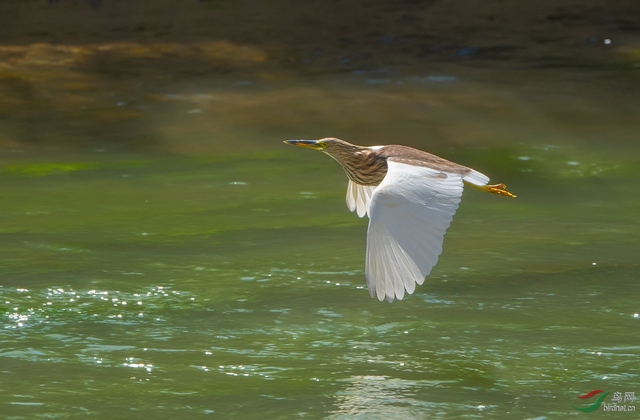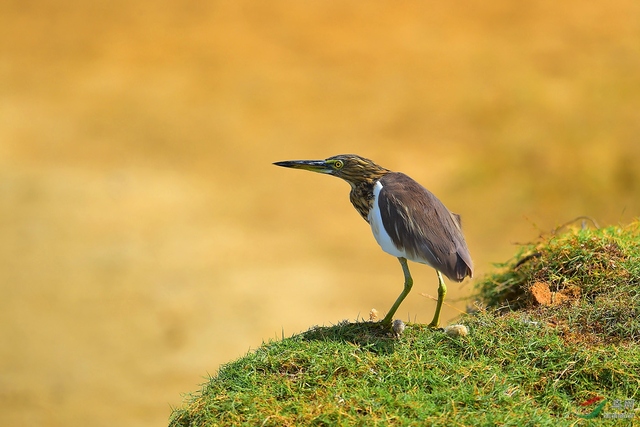Ardeola grayii
IUCN
LCBasic Information
Scientific classification
- name:Ardeola grayii
- Scientific Name:Indian Pond-heron, Indian Pond Heron, Indian Pond-Heron
- Outline:Wading birds
- Family:A.grayii Ardeola Ardeidae
Vital signs
- length:About 460 mm
- Weight:About 253 grams
- lifetime:
Feature
A medium-sized wading bird, usually hunched, with a body that flashes with contrasting olive and brown markings when in flight, and a pair of bright white wings. A short, thick neck and a short, thick beak of light yellow or brown. Legs are red. In summer, adults grow long frills on their necks. When taking flight, their white wings make them stand out. The Indian Pond Heron is very well camouflaged, often allowing people to approach before quickly flying away, which has led local folk to believe that the bird is short-sighted or has eye problems.
Distribution and Habitat
The habitat is almost always near water bodies, lakes, rivers, mangroves, wetlands. Usually inhabits marsh wetlands or waters with floating plants such as water hyacinth. But the species is increasingly seen near settlements, foraging near public garbage dumps, which can cause food poisoning and foreign objects blocking the intestines of birds.
Distribution: Resident birds: Bangladesh, Bhutan, India, Iran, Myanmar, Nepal, Pakistan and Sri Lanka, Persian Gulf, Andaman and Nicobar Islands;
Breeding grounds: Maldives;
Non-breeding grounds: Oman and UAE;
Wandering (non-breeding grounds): Seychelles and Yemen;
Wandering: Thailand
Appearance
The body length is about 46 cm and the wingspan is 75-90 cm. It is a medium-sized wading bird whose appearance completely changes depending on the breeding season. In normal times, there are brown-gray vertical lines on a white background on a large part of the head, neck, chest and abdomen. The lower abdomen to the tail is white. The cover feathers and back are almost the same color as the stripes, but slightly darker. The primary and secondary flight feathers are light brown. During the mating season, the yellow legs turn salmon color and the plumage changes completely: the back turns dark brown, the nape, hood and parts of the cheeks turn light gray, and the neck changes from gray to yellow. The entire transformation is the beak, which in normal times is yellow on the lower jaw and gray on the upper jaw, and both parts turn yellow with a black tip. Finally, during breeding, a tuft of white fuzz will appear on the back of the neck.
The beak is strong, and the feathers on the head,
Details

The Indian Pond Heron (Ardeola grayii) is a medium-sized wading bird, a small heron in the family Ardeidae in the order Pelecaniformes. It originates from the Old World, breeding in southern Iran, extending eastwards to the Indian subcontinent, Myanmar, and Sri Lanka. They are widespread and common, but can be easily overlooked as they quietly hunt at the edge of small ponds or roost close to human settlements. When they take flight, they are very conspicuous, with their bright white wings contrasting with the concealing olive and brown stripes on their bodies. Their camouflage is so excellent that they can be approached at close range before they take off, a behavior that has led to folk names and the belief that these birds are nearsighted or blind.
Distribution: Resident: Bangladesh, Bhutan, India, Iran, Myanmar, Nepal, Pakistan and Sri Lanka, Persian Gulf, Andaman and Nicobar Islands;
Breeding: Maldives;
Non-breeding: Oman and UAE;
Wandering (non-breeding): Seychelles and Yemen;
Wandering: Thailand
The Indian Pond Heron weighs about 253 grams, is about 460 mm long, has a wingspan of about 207.4 mm, a wingspan of 750-900 mm, a bill length of about 72.4 mm, a bill width of about 9.3 mm, a bill thickness of about 12.1 mm, a tarsus length of about 57.3 mm, and a tail length of about 74 mm. The Indian Pond Heron is short and stocky, with red legs and a hunchback. They are very special among herons, with a thick short neck, a short and thick beak of light yellow or brown and thick, and a yellow-brown back. When flying, the wings look completely white and the body is dark brown. The body flashes with hidden markings of contrasting olive and brown colors. They have bright white wings and in summer, adults grow long feathers on their necks. The bill is strong, the feathers on the head, neck and upper chest are extended, the plumage changes greatly during the breeding season, and the crest feathers are extended to a spear shape. The tail is rounded, with 12 tail feathers, and the tarsus is strong and almost as long as the middle toe (with claws). The feet and toes are slender, the tibia is partially naked, the feet have three toes in front and one toe behind, and the claws of the middle toes have a comb-like ridge. Sexes are the same color. The body is spindle-shaped, the body feathers are loose, with filamentous wing feathers, and the adults have long feathers on their necks. When they take off, they change from dull colors to conspicuous white wings, making them very prominent. They are very similar to the spotted heron (Ardeola ralloides), but with a darker back. East of its distribution range, it is replaced by the pond heron (Ardeola bacchus). The appearance changes completely depending on the breeding season. Normally, the head, neck, chest, and a large part of the abdomen have vertical stripes of brownish-grey with a white background. The lower abdomen to the tail is white, the feathers and back are almost the same color as the stripes, but slightly darker, and the primary and secondary flight feathers are light brown. During the mating season, the yellow legs turn salmon-colored and the plumage changes completely: the back becomes dark brown, the nape, cap, and part of the cheeks become light gray, and the neck changes from gray to yellow. The whole transformation is the bill, which is yellow in the lower jaw and gray in the upper jaw in normal times, and both parts become yellow with a black tip. Finally, during the breeding period, a tuft of white down appears on the back of the neck. Red variant (Erythristic) plumage has been recorded. The population found in the Maldives has been suggested as a new species, but it is not widely accepted. It forms a superspecies with the closely related pond herons, Java pond herons, and Madagascar pond herons.
The bird was first described by Colonel W. H. Sykes in 1832 and given its scientific name after John Edward Grey. Karyotype studies have shown that the Pond Heron has 68 chromosomes (2N).

Behavior and Ecology: Active during the day or night. Often social, usually in small groups, standing at the edge of ponds and open water or in shallow water, sometimes solitary, staying with other herons. Generally not vocal, but may make a piercing call when startled or when approaching a nest. They can be observed hunting on water lilies. The species is usually very hierarchical in position and will take off suddenly, as if they only noticed the person or animal disturbing it at the last moment. They grab food quickly with their bill. The contrasting white wings flash into view when taking off, and the neck is usually hunched, making it appear shorter. They are very common in India, usually feeding alone, but during the dry season, when there is a high density of prey in small wetlands, sometimes considerable numbers of individuals feeding at close range. They breed in a semi-social manner. Sometimes they can be found feeding on garbage dumps. During the dry season, they sometimes feed on well-watered lawns or even on dry grass. When feeding, they will allow close approach, only startling away if too close. They sometimes form communal roosts in boulevard trees in busy urban areas.
Food and Foraging: The Indian Pond Heron's foraging sites are marshy wetlands. During the dry season, they forage on watered lawns and even dry grasslands, sometimes forming communal roosts, often found in trees on downtown avenues. They usually forage at the edges of ponds, but also make extensive use of floating vegetation such as water hyacinths to access deeper waters. They will sometimes swim on the surface of the water or fish from the air and land in deeper waters. They have also been observed flying in the air and catching fish jumping out of the water. Sometimes, they will fly low over the water, driving frogs and fish toward the shore, and then land on the shore to hunt. They have also been recorded picking up bread crumbs and throwing them on the water to lure fish.
The main diet of these birds includes crustaceans, aquatic insects, fish, tadpoles, and sometimes leeches (Herpobdelloides sp.). Outside wetlands, these herons eat insects (including crickets, dragonflies and bees), fish (Barilius was considered important in a study in Chandigarh) and amphibians.

Reproduction: Indian Pond Heron is usually silent but emits harsh, hoarse calls to threaten other birds approaching their nests. Bright red legs during the breeding season The breeding season begins with the onset of the monsoon. They nest in small colonies, often mixed with other wading birds, usually on platforms in mangroves or shrubs near lakes and ponds. Most nests are built in large trees about 9 to 10 meters high. The male collects nesting materials while the female builds the nest. The pair can use the same nest every year. The breeding season starts in May and lasts until September, but in South India and Sri Lanka, the breeding season may be delayed from November to February. Each clutch contains 3 to 5 eggs. Both parents incubate the eggs together and the eggs hatch in batches over 18 to 24 days. Both males and females feed the young. Fish is the main food. Undisturbed nest sites may be reused year after year.
Causes of mortality: They have few natural predators, but injured birds may be preyed on by birds of prey. An arbovirus that causes Balagodu disease has been isolated in this bird, as have trematodes and a variety of other parasites. Antibodies to Japanese encephalitis and West Nile virus have been detected in pond herons and cattle egrets in southern India. Heavy metals acquired from foraging in polluted waters may be particularly concentrated in the tail feathers.
Place in culture: In Sri Lanka, the bird is called kana koka, which translates to "half-blind heron" in Sinhalese. The Hindustani phrase "bagla bhagat" is used to describe a "wolf in sheep's clothing" or hypocrite who looks like a meditating saint and appears in a Marathi proverb. The paddy bird also appears as a character in the Shithopadsha, in one of the stories, where it injures itself to save the king. Anglo-Indian naturalist writers have noted the bird's striking color variation. Philip Stewart Robinson described the bird as "all grey when sitting, and all white when flying". It is said that in the past many people in India ate this bird.
At the height of the feather trade, feathers were collected from the "paddy bird" and exported to Britain.








